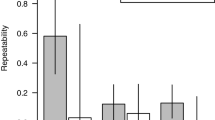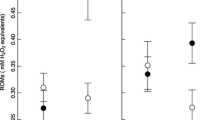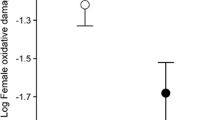Abstract
In this study, we estimated the environmental and genetic components of two variables related to avian oxidative stress using wild nestlings of the Eurasian kestrel (Falco tinnunculus). The study was carried out during two breeding seasons. In the first season, we assessed the between- and within-nest resemblance in serum reactive oxygen metabolites (ROMs) and total serum antioxidant barrier (OXY). In the second season, we carried out a cross-fostering experiment to determine the importance of environmental and genetic factors on ROMs and OXY. The 23.5% of ROMs variance was explained by the nest of origin, indicating a main genetic component. In contrast, the 52.8% of OXY variance was explained by the nest of rearing, indicating that this variable was more influenced by environmental components. These findings suggest that variations in ROMs and OXY could reflect, respectively, the expression of different genetic polymorphisms and differences in dietary uptake of antioxidants.
Similar content being viewed by others
References
Ames BN, Shigenaga MK, Hagen TM (1993) Oxidants, antioxidants, and the degenerative diseases of aging. Proc Natl Acad Sci USA 90:7915–7922
Beckman KB, Ames BN (1998) The free radical theory of aging matures. Physiol Rev 78:547–581
Bortolotti GR, Tella JL, Forero MG, Dawson RD, Negro JJ (2000) Genetics, local environment and health as factors influencing plasma carotenoids in wild American kestrels (Falco sparverius). Proc R Soc Lond B 267:1433–1438
Costantini D, Casagrande S, De Filippis S, Brambilla G, Fanfani A, Tagliavini J, Dell’Omo G (2006) Correlates of oxidative stress in wild kestrel nestlings (Falco tinnunculus). J Comp Physiol B (in press)
Dell’Omo G, Costantini D, Di Lieto G, Casagrande S (2006) Uccelli e linee elettriche. Alula (in press)
Daly AK, Cholerton S, Gregory W, Idle JR (1993) Metabolic polymorphisms. Pharmacol Therap 57:129–160
Falconer DS (1989) Introduction to quantitative genetics. Longman Scientific and Technical, England
Finkel T, Holbrook NJ (2000) Oxidants, oxidative stress and the biology of ageing. Nature 408:239–247
Fisher RA (1930) The genetical theory of natural selection. Dover, New York
Gebhardt-Heinrich SC, Noordwijt AJ van (1991) Nestling growth in the great tit. I. Heritability estimates under different environmental conditions. J Evol Biol 2:341–362
Gredilla R, Sanz A, Lopez-Torres M, Barja G (2001) Caloric restriction decreases mitochondrial free radical generation at Complex I and lowers oxidative damage to mitochondrial DNA in the rat heart. FASEB J 14:1589–1591
Gustafsson L (1986) Lifetime reproductive success and heritability: empirical support for Fisher’s fundamental theorem. Am Nat 128:761–764
Halliwell BH, Gutteridge JMC (1989) Free radicals in biology and medicine. Oxford University Press, Oxford
Halliwell BH, Gutteridge JMC (1990) The antioxidants of human extracellular fluids. Arch Biochem Biop 280:1–8
Harman D (1956) Aging: a theory based on free radical and radiation chemistry. J Gerontol A 11:298–300
Harman D (1972) The biological clock: the mitochondria?. J Am Geriatr Soc 20:145–147
Hoffman AA, Parsons PA (1991) Evolutionary genetics and environmental stress. Oxford University Press, Oxford
Kimura M (1958) On the change of population fitness by natural selection. Heredity 12:145–167
Leffler JE (1993) An introduction to free radicals. Wiley, New York
Lessells CM, Boag PT (1987) Unrepeatable repeatabilities: a common mistake. Auk 104:116–121
Lin H, Decuypere E, Buyse J (2004a) Oxidative stress induced by corticosterone administration in broiler chickens (Gallus gallus domesticus) 1. Chronic exposure. Comp Biochem Physiol B 139:737–744
Lin H, Decuypere E, Buyse J (2004b) Oxidative stress induced by corticosterone administration in broiler chickens (Gallus gallus domesticus) 2. Short-term effect. Comp Biochem Physiol B 139:745–751
Martin GM, Austad SN, Johnson TE (1996) Genetic analysis of ageing: role of oxidative damage and environmental stresses. Nature Genetics 13:25–34
Masoro EJ (2002) Caloric restriction: a key to understanding and modulating aging. Elsevier, Amsterdam
McCleery RH, Pettifor RA, Armbruster P, Meyer K, Sheldon BC, Perrins CM (2004) Components of variance underlying fitness in a natural population of the great tit Parus major. Am Nat 164:E62–E72
Merilä J (1996) Genetic variation in offspring condition: an experiment. Funct Ecol 10:465–474
Merilä J, Sheldon BC (1999) Genetic architecture of fitness and nonfitness traits: empirical patterns and development of ideas. Heredity 83:103–109
Merilä J, Przybylo R, Sheldon BC (1999) Genetic variation and natural selection on blue tit body condition in different environments. Genet Res 73:165–176
Mousseau TA, Roff DA (1987) Natural selection and the heritability of fitness components. Heredity 59:181–197
Potti J, Moreno J, Merino S, Frías O, Rodríguez R (1999) Environmental and genetic variation in the haematocrit of fledgling pied flycatchers Ficedula hypoleuca. Oecologia 120:1–8
Price T, Schluter D (1991) On the low heritability of life history traits. Evolution 45:853–861
Roy NK, Wirgin I (1997) Characterization of the aromatic hydrocarbon receptor gene and its expression in Atlantic tomcod. Arch Biochem Biop 344:373–386
Simic MG, Bergtold DS (1991) Dietary modulation of DNA damage in humans. Mutat Res 250:17–24
Smith HG, Wettermark K-J (1995) Heritability of nestling growth in cross-fostered European starlings Sturnus vulgaris. Genetics 141:657–665
Sohal RS, Ku HH, Agarwal S, Forster MJ, Lal H (1994) Oxidative damage, mitochondrial oxidant generation and antioxidant defenses during aging and in response to food restriction. Mech Ageing Dev 74:121–133
Sohal RS, Weindruch R (1996) Oxidative stress, caloric restriction, and aging. Science 273:59–63
Weindruch R, Walford RL (1988) The retardation of aging and disease by dietary restriction. Thomas, Springfield
Wiebe KL, Bortolotti GR (1994) Food supply and hatching spans of birds: energy constraints or facultative manipulation? Ecology 75:813–823
Acknowledgements
We thank Stefania Casagrande, Stefania De Filippis and Giuseppe Di Lieto for lab and field assistance in 2003; Gianfranco Brambilla and Alberto Fanfani for their support of this research; Peter W. Christie for the revision of English; and two anonymous reviewers for valuable comments that improved the manuscript. Part of the work was sponsored by the scientific association Ornis italica. David Costantini was supported by a PhD fellowship from the University of Rome La Sapienza.
Author information
Authors and Affiliations
Corresponding author
Additional information
Communicated by G. Heldmaier
Rights and permissions
About this article
Cite this article
Costantini, D., Dell’Omo, G. Environmental and genetic components of oxidative stress in wild kestrel nestlings (Falco tinnunculus). J Comp Physiol B 176, 575–579 (2006). https://doi.org/10.1007/s00360-006-0080-0
Received:
Revised:
Accepted:
Published:
Issue Date:
DOI: https://doi.org/10.1007/s00360-006-0080-0




